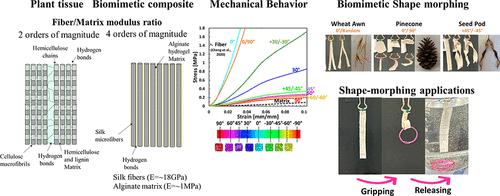当前位置:
X-MOL 学术
›
ACS Biomater. Sci. Eng.
›
论文详情
Our official English website, www.x-mol.net, welcomes your feedback! (Note: you will need to create a separate account there.)
Plant Biomimetic Principles of Multifunctional Soft Composite Development: A Synergistic Approach Enabling Shape Morphing and Mechanical Robustness
ACS Biomaterials Science & Engineering ( IF 5.8 ) Pub Date : 2024-02-21 , DOI: 10.1021/acsbiomaterials.3c01163 Gital Shteinberg 1 , Rami Haj-Ali 2 , Flavia Libonati 3 , Mirit Sharabi 1
ACS Biomaterials Science & Engineering ( IF 5.8 ) Pub Date : 2024-02-21 , DOI: 10.1021/acsbiomaterials.3c01163 Gital Shteinberg 1 , Rami Haj-Ali 2 , Flavia Libonati 3 , Mirit Sharabi 1
Affiliation

|
Plant tissues are constructed as composite material systems of stiff cellulose microfibers reinforcing a soft matrix. Thus, they comprise smart and multifunctional structures that can change shape in response to external stimuli due to asymmetrical fiber alignment and possess robust mechanical properties. Herein, we demonstrate the biomimetics of the plant material system using silk fiber-reinforced alginate hydrogel matrix biocomposites. We fabricate single and bilamellar biocomposites with different fiber orientations. The mechanical behavior of the biocomposites is nonlinear, with large deformations, as in plant tissues. In general, the bilamellar system shows increased modulus, strain UTS, and toughness compared to the single-lamellar system for most of the tested orientations. Overall, the biocomposites present a wide range of elastic modulus values (3.0 ± 0.6–104.7 ± 11.3 MPa) and UTS values (0.23 ± 0.04–12.5 ± 2.0 MPa). The bilamellar biocomposites demonstrated shape-transforming abilities with diverse morphing modes, emulating different plant tissues and creating complex shape-morphing structures. These multifunctional biocomposites possess tunable and robust mechanical properties, controllable shape-morphing deformations, and the ability to self-controlled encapsulation, grip, and release objects. By harnessing biomimetic principles, these soft, smart, and multifunctional materials hold potential applications spanning from soft robotics, medicine, and tissue engineering to sensing and drug delivery.
中文翻译:

多功能软复合材料开发的植物仿生原理:实现形状变形和机械鲁棒性的协同方法
植物组织被构造为由硬质纤维素微纤维增强软基质的复合材料系统。因此,它们包含智能多功能结构,由于不对称的纤维排列,可以响应外部刺激而改变形状,并具有强大的机械性能。在此,我们展示了使用丝纤维增强藻酸盐水凝胶基质生物复合材料的植物材料系统的仿生学。我们制造具有不同纤维取向的单层和双层生物复合材料。生物复合材料的机械行为是非线性的,具有较大的变形,就像在植物组织中一样。一般来说,对于大多数测试方向,与单层系统相比,双层系统显示出更高的模量、应变 UTS 和韧性。总体而言,生物复合材料呈现出广泛的弹性模量值(3.0 ± 0.6–104.7 ± 11.3 MPa)和UTS值(0.23 ± 0.04–12.5 ± 2.0 MPa)。双层生物复合材料表现出具有多种变形模式的变形能力,模拟不同的植物组织并创建复杂的变形结构。这些多功能生物复合材料具有可调且坚固的机械性能、可控的形状变形以及自控封装、抓握和释放物体的能力。通过利用仿生原理,这些柔软、智能和多功能材料具有从软机器人、医学和组织工程到传感和药物输送的潜在应用。
更新日期:2024-02-22
中文翻译:

多功能软复合材料开发的植物仿生原理:实现形状变形和机械鲁棒性的协同方法
植物组织被构造为由硬质纤维素微纤维增强软基质的复合材料系统。因此,它们包含智能多功能结构,由于不对称的纤维排列,可以响应外部刺激而改变形状,并具有强大的机械性能。在此,我们展示了使用丝纤维增强藻酸盐水凝胶基质生物复合材料的植物材料系统的仿生学。我们制造具有不同纤维取向的单层和双层生物复合材料。生物复合材料的机械行为是非线性的,具有较大的变形,就像在植物组织中一样。一般来说,对于大多数测试方向,与单层系统相比,双层系统显示出更高的模量、应变 UTS 和韧性。总体而言,生物复合材料呈现出广泛的弹性模量值(3.0 ± 0.6–104.7 ± 11.3 MPa)和UTS值(0.23 ± 0.04–12.5 ± 2.0 MPa)。双层生物复合材料表现出具有多种变形模式的变形能力,模拟不同的植物组织并创建复杂的变形结构。这些多功能生物复合材料具有可调且坚固的机械性能、可控的形状变形以及自控封装、抓握和释放物体的能力。通过利用仿生原理,这些柔软、智能和多功能材料具有从软机器人、医学和组织工程到传感和药物输送的潜在应用。



























 京公网安备 11010802027423号
京公网安备 11010802027423号